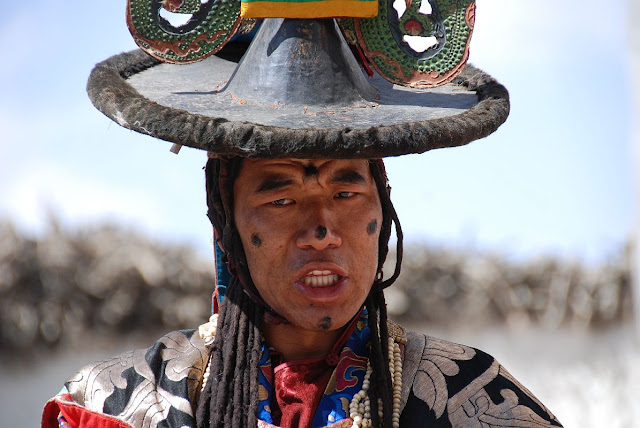- Dhana Kumari Bajracharya, 63, lives in near-total isolation in Patan city
- She became a goddess in 1954 aged two and spent 30 years only leaving the house when carried in an ornate wooden palanquin
- After being forced to quit in the mid-1980s, she refused to leave her home
- But April's massive earthquake forced her to flee the property on foot
When a massive earthquake hit Nepal in April killing 8,800 people, Nepal's longest-serving 'living goddess' was forced to do the unthinkable - walk the streets for the first time in her life.
As the 7.8 magnitude tremor hit the historic city of Patan, south of Kathmandu, the home in Dhana Kumari Bajracharya had lived in isolation for 30 years came under threat of collapse.
In fear of her life and believing the gods were angry at a decline in traditional values, Bajracharya, 63, left her quarters for the first time in three decades.
What was even more remarkable was that before the earthquake Bajracharya had never actually walked in public - having entered her cloistered life at the age of two only ever being carried in an ornate wooden palanquin during her subsequent, rare public appearances.
 |
| Living goddess: As the 7.8 magnitude tremor hit the historic city of Patan, south of Kathmandu, the home in Dhana Kumari Bajracharya had lived in isolation for 30 years came under threat of collapse |
'I had never thought about leaving the house like that,' she told, clearly still traumatised by the disaster that claimed more than 8,800 lives,' she told AFP in a rare interview.
'Perhaps the gods are angry because people don't respect traditions as much anymore,' Bajracharya added.
As the disaster ripped through Nepal, shaking Bajracharya's five-storey home, her family stayed indoors, waiting to see if the retired Kumari would break tradition and walk out with them.
'We couldn't just leave the house like everyone else, we had to think of her. We didn't know what to do,' said her niece, Chanira Bajracharya.
'But when nature forces you, you do the unthinkable,' she added.
Bajracharya was enthroned in 1954 when she was just two years old and reigned for three decades as the Kumari of Patan.
The Kumari - a pre-pubescent girl from the Newar community - is considered an embodiment of the Hindu goddess Taleju.
Selection criteria is strict and includes a number of specific physical attributes from an unblemished body to a chest like a lion and thighs like a deer
.
Unlike Kathmandu's 'living goddess' who must move to an official residence, the Patan Kumari is allowed to live with her family, but can only emerge on feast days when she is paraded through the city to be worshipped.
'I loved going out during the festivals the most,' said Bajracharya, remembering how devotees lined up along Patan's narrow streets, eager to receive her blessings.
The Patan Kumari is traditionally dethroned once she begins to menstruate and, since Bajracharya never started her periods, she continued to serve well into her thirties.
But in 1984, Nepal's then crown prince Dipendra, who would go on to massacre his family 17 years later, stirred up a controversy which eventually ended her tenure.
'Why is she so old?' the 13-year-old prince reportedly asked when he saw Bajracharya during a festival, prompting priests to replace her with a young girl.
Thirty years later, the memory of her abrupt dismissal still stings.
'They had no reason to replace me,' she said. 'I was a little angry... I felt the goddess still resided in me.'
Manamaiju
Situated in Manamaiju VDC near Balaju, the temple of Manamaiju is the tradional Nepalese style structure with multiple roofs. An inscription dated Nepal Samvat 786 is found here, which dates the temple to at least the medieval era. According to historical records, King Girvana Yuddha Bikram Shah donated some land to the temple in 1801 AD. Manamaiju is considered the goddess of beauty and it is believed that she can remove black spots and cure diseases that affect the face. According to a popular legend, Mana was a young girl with terrible black spots on her face and an ugly visage. She was later transformed into a goddess by Lord Indra and given the task of curing ailments that made people ugly. The tradition of offering Nauratha Snana to the goddess is popular at the temple during Navaratra.
Situated in Manamaiju VDC near Balaju, the temple of Manamaiju is the tradional Nepalese style structure with multiple roofs. An inscription dated Nepal Samvat 786 is found here, which dates the temple to at least the medieval era. According to historical records, King Girvana Yuddha Bikram Shah donated some land to the temple in 1801 AD. Manamaiju is considered the goddess of beauty and it is believed that she can remove black spots and cure diseases that affect the face. According to a popular legend, Mana was a young girl with terrible black spots on her face and an ugly visage. She was later transformed into a goddess by Lord Indra and given the task of curing ailments that made people ugly. The tradition of offering Nauratha Snana to the goddess is popular at the temple during Navaratra.
Balaju Park
One of the hideouts for the dwellers of Kathmandu city is Balaju Park where they can organize picnics with family and colleagues. This place is not only rich in clean and green ambience but also holds a historical significance as it was constructed during the regime of the Malla king Pratap Malla. Even the revered poet of Nepal Bhanubhakta Acharya has extolled the beauty of this venue wholeheartedly in one of his poems.
This park is also named as Baisdhara as there are twenty-two taps made of stone (Bais: Twenty-two; Dhara: Tap). Pilgrims can also worship the idol of Lord Bishnu which is similar to that of Budhanilkantha temple. A variety of fish are found in the big pond inside the park. For those who are fond of swimming, the place offers you a very neat and clean swimming pool.
The Tiji festival is a three-day ritual known as "The chasing of the Demons", centered around the Tiji myth celebrated in Mustang, Nepal. Tiji tells the story of a deity named Dorje Jono who must battle against his demon father to save the Kingdom of Mustang from destruction. The demon father wreaks havoc on Mustang by creating a water shortage which, in this extremely arid land, is the most precious life-sustaining resource. Dorje Jono eventually defeats the demon and banishes him from the land.
Previous PostOlder Posts
Home




























































